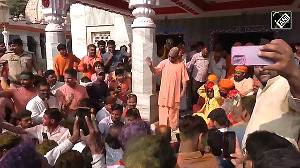A lethal mixture of RDX and ammonium nitrate packed into cars and motorbikes exploded within a span of one hour in at least nine locations in four of Assam's western districts, culminating in the biggest ever terrorist strike in this state in India's Northeast.
Till the last count, 81 persons, all civilians, had been killed in the explosions. The maximum fatalities of 45 occurred in the capital, Dispur and adjoining Guwahati, the most protected city in the state, where three car bomb explosions took place.
Assam is no stranger to terrorism. As many as 436 lives were lost to armed violence in 2007, more than any other state in the north-eastern region, where almost every state has witnessed some degree of violent activity by the non-state groups.
According to the ministry of home affairs, 209 persons have been killed in Assam till August 31 this year. In the post-August period, Assam witnessed the Bodo-Muslim clashes which claimed nearly 57 lives. Apart from that a number of terrorism-related incidents, involving at least five active militant outfits, have taken place in the state.
Even then, the October 30 blasts was something that caught everybody unawares, not just because of the sheer scale of colossal fatalities, but also the utter cluelessness that continues to mark the investigations regarding the actual perpetrators behind the attack.
It arises primarily from a clear sense of disbelief in the ability and inclination of any of the existing militant formations in the state to carry out such horrific acts resulting in civilian casualties. Thus, fingers have been pointed at the jihadis, primarily the Bangladesh based Harkat-ul Jihad-al Islami , who many think has gained strength and extended its reach in the state progressively over the years.
It is convenient to link HuJI's support network with the bourgeoning migrant population from Bangladesh who have been accused of dramatically altering the demography in about five of Assam's 27 districts. HuJI and about five other Islamist militant outfits operating in Assam are said to have found safe havens and also actively recruit heavily among such population.
On serious deliberations, however, neither HuJI nor the Islamist militants can be blamed to have carried out the attacks single-handedly, without significant support from a potent local militant outfit. Although HuJI's involvement has been discerned behind a number of terrorist attacks in Indian cities in the past few years, its activity in the northeastern region in general and Assam in particular has been almost negligible.
Only in the past couple of months, about nine HuJI cadres were killed in two separate encounters in Goalpara and Dhubri districts of the state. HuJI clearly lacks organisational strength and operational capacities to orchestrate a terrorist attack of the October 30 variety. In addition, involvement of jihadi forces like HuJI does not explain the two explosions in Barpeta Road, a predominantly Muslim area.
Moreover, the Assam police, which now claims to be looking at the jihadi angle to the attack, has always played down the threat of Islamists in the state. Even the two recent incidents involving the killing of HuJI cadres do not even find mention in the website of the Assam Police.
If it is not primarily HuJI, one can also safely discount the involvement of the National Democratic Front of Bodoland , the only surviving Bodo militant formation. The other existing outfits, such as the Karbi Longri North Cachar Hills Liberation Front, the Dima Halim Daogah or the Black Widow are too localised in their areas of operation to have carried out an attack of this magnitude. The attacks do not suit any of their interests.
The prime player certainly cannot be the Islamic Security Force-Indian Mujahideen, which purportedly sent a text message claiming responsibility for the blasts. In any event, no such organisation ever existed in Assam, whose supposed propping up is nothing but the result of a poor imagination.
This brings the focus to United Liberation Front of Asom as the possible suspect, in spite of the fact that the outfit managed to issue a denial note within a couple of hours of the blast. Suspicion hovers quite strongly on ULFA, not just because it is the result of an elimination method, but also due to the past nature of its activities and its present state of affairs, which necessitates orchestration of a major strike.
ULFA, since its inception in 1979, has been involved in countless terror attacks in Assam and the nature of attacks has depicted increased sophistication and lethality over the years. A number of ULFA cadres have been experts in assembling IEDs.
IEDs and grenades have replaced attacks of the hit and run variety as the dominant mode of its warfare in recent years. The outfit has used RDX and plastic explosives in many of its recent attacks. It has also detonated, at least on one occasion in 2007, a car bomb in Guwahati.
The exact locations where the October 30 explosions took place, have also been spots where the outfit has carried out attacks in the past. Thus, the outfit has both expertise and the experience to carry out attacks of this nature. ULFA is no stranger to serial blasts either. Three years ago, on August 26, it had organised a chain of seven explosions across five districts that left five persons dead and over 100 injured.
Even for the October 1 serial explosions in Tripura's capital Agartala, ULFA had trained All Tripura Tiger Force militants in Bangladesh.
Too much appears to have been read into the supposed weakness of ULFA in recent times. Indeed, the June 2008 defection of two companies in the 28th battalion of ULFA has been a serious setback to the outfit in the upper Assam districts, close to Arunachal Pradesh and Myanmar.
However, the 709th battalion, ULFA's fighting force in the districts where the October 30 explosions took place, remains intact. After ULFA activities in upper Assam districts have declined, the 709th battalion has emerged as the primary strike force for the outfit.
The porous Indo-Bangladesh border and the Garo hills region in Meghalaya that separates Bangladesh and some of Assam's districts, ensure a steady supply of men and material for the 709th battalion. Even then, it is certainly a 'job well done' for this military formation to organise these extremely sophisticated explosions.
It was almost a calling for the Bangladesh-based top ULFA leadership to organise something of this nature to surprise and silence people who appeared to have written its obituary.
HuJI's old association with ULFA does make it a secondary player in the entire episode. After all, both outfits are known to have entered into a pact, as late as June 2008 to operate jointly in Assam.
Identifying the players behind the explosions after all is not such an arduous task. The challenge, however, starts right after this. What can be done to prevent a repetition of such catastrophic acts of terror and violence?
Dr Shanthie Mariet D'Souza is associate fellow, Institute for Defence Studies & Analyses, New Delhi and Dr Bibhu Prasad Routray is Research Fellow, Institute for Conflict Management, New Delhi.






 © 2025
© 2025